Soccer is a fun sport that can keep you physically active. It is generally safe, and players suffer injuries at a lower rate than those of American football players. Even though injuries are not as common, they still happen. However, most soccer injuries can be prevented with warmups and exercises.
If you or a loved one are injured playing soccer, it is important you seek proper treatment immediately. Do not wait, as the injury can get worse. To make sure the injury is treated correctly, contact Sydney Sports & Exercise Physiology.
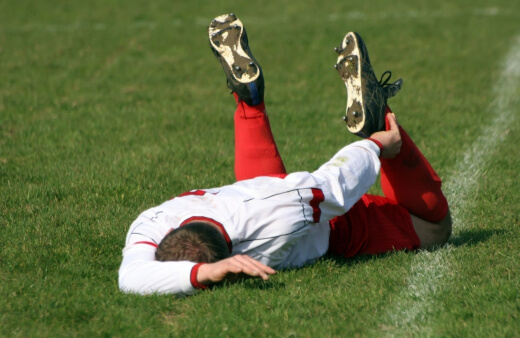
9 Most Common Soccer Injuries
1. Ankle Sprain
An ankle sprain happens when the ligaments around the ankle are stretched and torn. There are three common ankle sprains that occur when playing soccer. These are lateral sprains, medial sprains, and syndesmotic sprains.
Types of Ankle Sprains
Lateral ankle sprains
Can occurs when using the top of the foot to kick the ball. This movement can damage the ligaments located on the outside of the ankle.
Medial ankle sprains
Can happen when turning the toes up and out. This movement can damage the ligaments on the inside of the ankle.
Syndesmotic sprains
Often caused by hyperdorsiflexion. These sprains can happen when you point the toes out too far or up too far.
How Serious are Ankle Sprains?
The severity of ankle sprains can vary from mild to severe. They are classified in 3 categories: 1st degree, 2nd degree and 3rd degree. Depending on the level of the injury, the ankle can heal within 2 to 90 days with proper treatment.
How to Prevent Ankle Sprains
The best way to prevent a sprained ankle is by having strong ankle muscles. Soccer players need to perform ankle strengthening exercises on a regular basis. Call us to learn more about strengthening your ankles the right way. Other ways to prevent ankle sprains are:
- Warm-up and stretch your ankles before playing
- Cool-down after playing
- Wear shoes that support your ankle
- Replace shoes when they wear out
- Play soccer on level ground
- Do not play if there are any hazards in the way
- Practice balance improving exercises
- Strengthen all lower body muscles
- Wrap your ankles
Here is a list of Ankle Strengthening Exercises.
2. Calf Strains
Calf strains is one of the most common football injuries and can occur when running, jumping, or performing other uncoordinated movements. These types of activities can overstretch the calf, damaging the muscle.
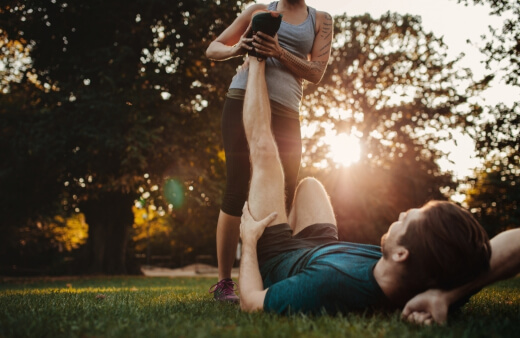
Types of Calf Strains
Gastrocnemius strains
Are the most common calf strain. The pain is usually located in the inner part of the lower leg. There may be bruising and swelling.
Plantaris Muscle Ruptures
Can happen when you lunge forward. This motion can cause the muscle to rupture, leading to a snapping pain in the back of the leg. There may be bruising and swelling on the back of the leg. The calf muscle may also cramp.
Soleus Muscle Strains
Are not as common as the other two. They are often more prevalent in runners. The strain can feel like tightness or soreness in the calf.
How Serious are Ankle Sprains?
The severity of ankle sprains can vary from mild to severe. They are classified in 3 categories: 1st degree, 2nd degree and 3rd degree. Depending on the level of the injury, the ankle can heal within 2 to 90 days with proper treatment.
How to Prevent Calf Strains
The calf muscle is often overlooked during training. However, it is a critical area that is at risk of injury. To help prevent calf strains while playing soccer:
- Warm-up before playing
- Cool-down after playing
- Include strength training into your regular routing
- Nutrition for injury prevention
- Improve flexibility
3. Clavicle Fracture
The clavicle is also known as the collarbone. The fracture often happens during a fall.
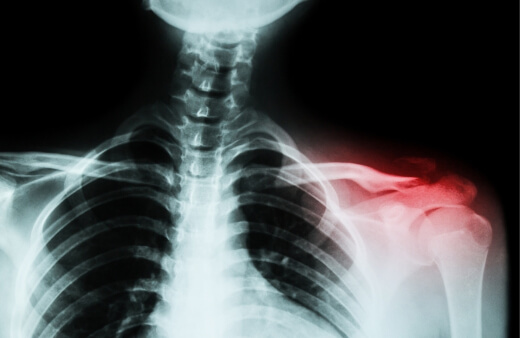
How Serious are Clavicle Fractures?
A clavicle fracture is a broken bone. It is usually able to heal without any complications. However, in rare instances, the broken bone can damage blood vessels and nerves. The fractures are often treated with surgery and physical therapy. A player can often return to playing after 3 months.
How to Prevent Clavicle Fractures
Clavicle fractures are hard to prevent. But there are some things you can do to strengthen your bones and your body to prevent a clavicle fracture.
- Nutrition for injury prevention
- Wear protective gear
- Incorporate strength training into your regular routine
- Improve flexibility
4. Concussion
A concussion is a mild brain injury produced by a quick blow to the head.
How Serious are Concussions?
Concussions are rarely life-threatening, but they can be dangerous. It is important to watch a person that has had a concussion closely. If they experience any of the following symptoms, seek medical attention immediately:
- Nausea
- Seizures
- Convulsions
- Confusion
- Agitation
- Restlessness
- Loss of consciousness
- Slurred Speech
- A constant headache
- Decreased coordination
- Numbness
- Drowsiness
- One large pupil
Concussions are often treated with rest and relaxation. It is important to limit all activities that require mental concentration.
How to Prevent a Concussion
The best way to prevent a concussion when playing soccer is by following the rules of the game. These rules have been put in place to keep you safe.
5. Achilles Tendonitis
Achilles Tendonitis occurs due to overuse of the Achilles tendon. The Achilles tendon is the tissue that connects the heel bone to the calf muscles.
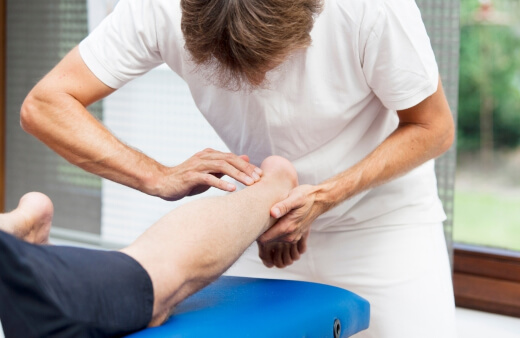
How Serious are Achilles Tendonitis?
Achilles Tendonitis is not often serious. However, over time, it can weaken the tendon. This makes the tendon more susceptible to a rupture. If the tendon ruptures, it often requires surgery to repair it. There are ways to prevent and treat Achilles Tendonitis. These include physical therapy and wearing the proper shoes.
How to Prevent Achilles Tendonitis
The Achilles tendon is the largest tendon in the body. It gets a lot of use while playing soccer. To help prevent tendonitis or a rupture you can:
- Warm-up before playing
- Cool-down after playing
- Incorporate strength training into your regular routine
- Improve flexibility
- Include plyometric drills
- Wear the proper footwear
- Nutrition for injury prevention
6. Knee Sprain
A knee sprain happens when the ligaments are overstretched. These ligaments connect the shinbone to the thigh bone. There are 4 ligaments that may be affected. These are the:
- Anterior Cruciate Ligament (ACL)
- Posterior Cruciate Ligament (PCL)
- Lateral Collateral Ligament (LCL)
- Medial Collateral Ligament (MCL)
How Serious are Knee Sprains?
The severity of knee sprains can vary. They are rated on their severity. There are 3 grades: Grade 1, Grade 2 and Grade 3. The treatment will depend on the grade of the injury. Treatment can include pain medication, ice, rest, immobilization, compression, physical therapy and surgery.
How to Prevent a Knee Sprain
Having strong leg muscles can help prevent knee strain. The muscles provide the knees extra support. It is important that your exercise regimen includes leg workouts.
- Warm-up before playing
- Cool down after playing
- Wear shoes that help support your ankle
- Pay attention to the ground you are plying on
- Remove any hazards that may be in the way
- Incorporate strength training into your regular routine
- Improve flexibility
7. Kneecap Bursitis
Kneecap bursitis is caused by the inflammation of the bursa. Bursa are small fluid-filled sacs located near the knee joint. Kneecap bursitis is often caused by friction from kneeling on hard surfaces. It can also be caused by a sharp blow to the knee and arthritis.
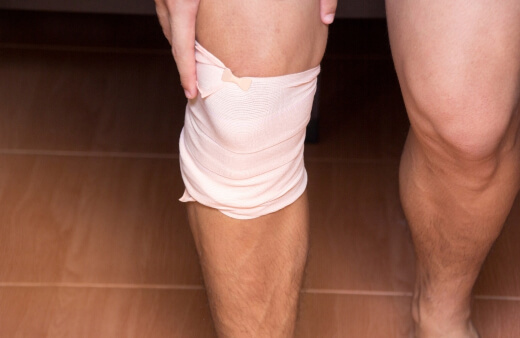
How Serious are Kneecap Bursitis?
Kneecap bursitis can reduce your mobility. Treatment for kneecap bursitis can include anything from resting, physical therapy to injections. With proper care, kneecap bursitis will get better within a couple of weeks. However, you may still experience flare-ups.
How to Prevent Kneecap Bursitis
Having strong leg muscles can help prevent a kneecap bursitis. The muscles in your legs provide extra knee support. To help prevent kneecap bursitis you can:
- Warm-up before playing
- Cool down after playing
- Avoid repetitive kneeling
- Incorporate strength training into your regular routine
- Improve flexibility
- Eat anti-inflammatory foods
8. Meniscal Tear
Meniscal tears are the most common type of knee injury. They occur when the knee is rotated. The meniscal are pieces of cartilage located between the thighbone and shinbone. When they are injured, they can cause stiffness, swelling and pain.
How Serious is a Meniscal Tear?
A meniscal tear can cause your knee to give out, causing you to fall. You may also feel pain and have trouble bending the knee. Over time, the injury may also lead to osteoarthritis. Recovery time will vary depending on the severity of the injury.
In mild cases, your doctor may prescribe rest and anti-inflammatory medication. If you must have surgery, a full recovery can take from 4 to 6 weeks with physical therapy.
How to Prevent a Meniscal Tear
The risk of suffering a meniscal tear can be lowered by strengthening the leg muscles. The muscles in your leg help stabilize the knee, lowering your risk of injury. To help prevent a meniscal tear:
- Warm-up before playing
- Cool down after playing
- Wear the proper shoes
- Incorporate strength training into your regular routine
- Improve flexibility
9. Wrist Fracture
Wrist fractures are most common among goalies. These fractures happen when trying to catch the ball or falling to the ground. There are 2 common wrist fractures. These are:
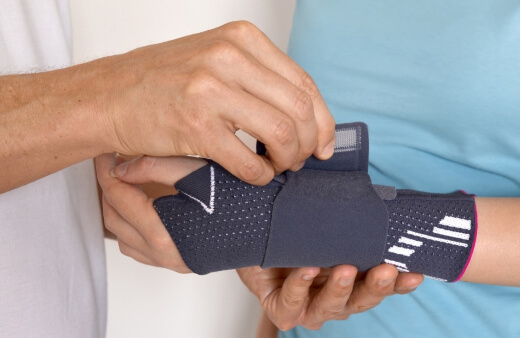
Colles’ Fracture
This type of fracture causes a physical deformity to the wrist. There is often immediate swelling.
Scaphoid Fracture
This type of fracture usually happens when someone falls on an outstretched arm. It is often mistaken for a sprained wrist.
How Serious is a Wrist Fracture?
A wrist fracture is not life-threatening. But it does need immediate attention. If it is left to heal on its own, the bones may not heal properly. This can lead to a decrease in motion and strength. A scaphoid fracture can take up to 3 months to heal. While a Colles’ fracture can take anywhere from 2 to 6 months.
How to Prevent a Wrist Fracture
Most wrist fractures happen during a fall. This can make it hard to prevent a fracture. However, by strengthening your bones and muscles you can help.
- Incorporate strength and condition training
- Nutrition for injury prevention
Visit SSEP for Injury Treatment and Prevention
If you are dealing with a soccer related injury or want to learn about injury prevention, we can help. At Sydney Sports and Exercise Physiology, our exercise physiologists will provide you with a personalised program based on your assessment. The sooner you start your program, the better you will feel.
